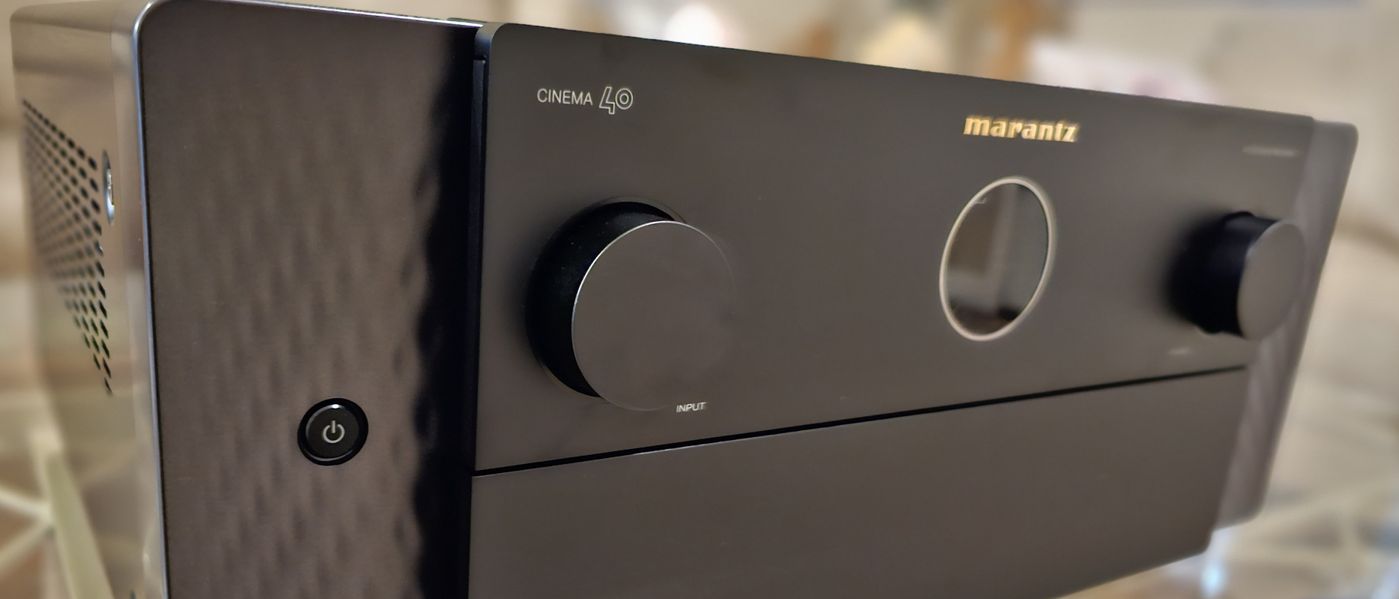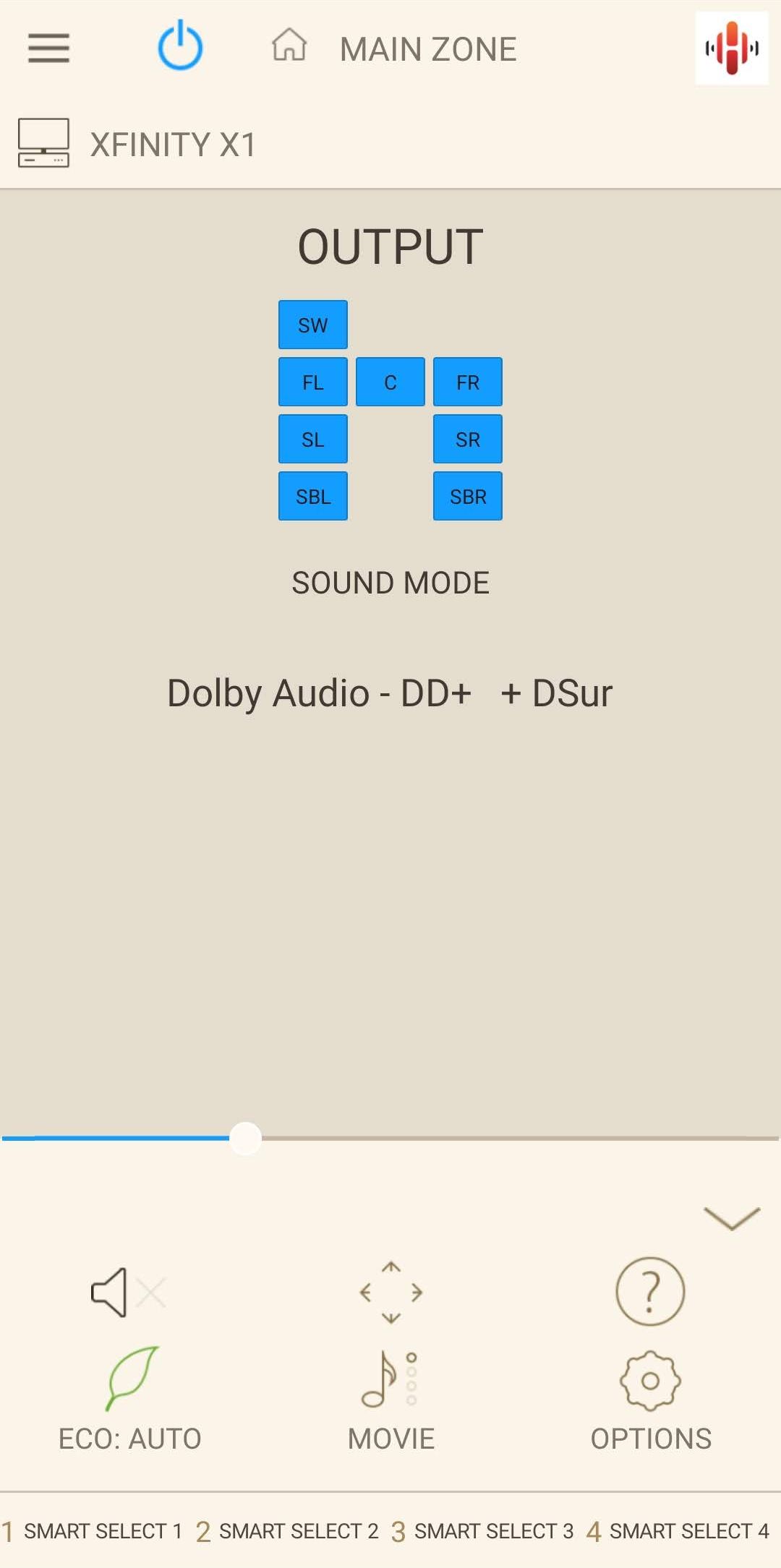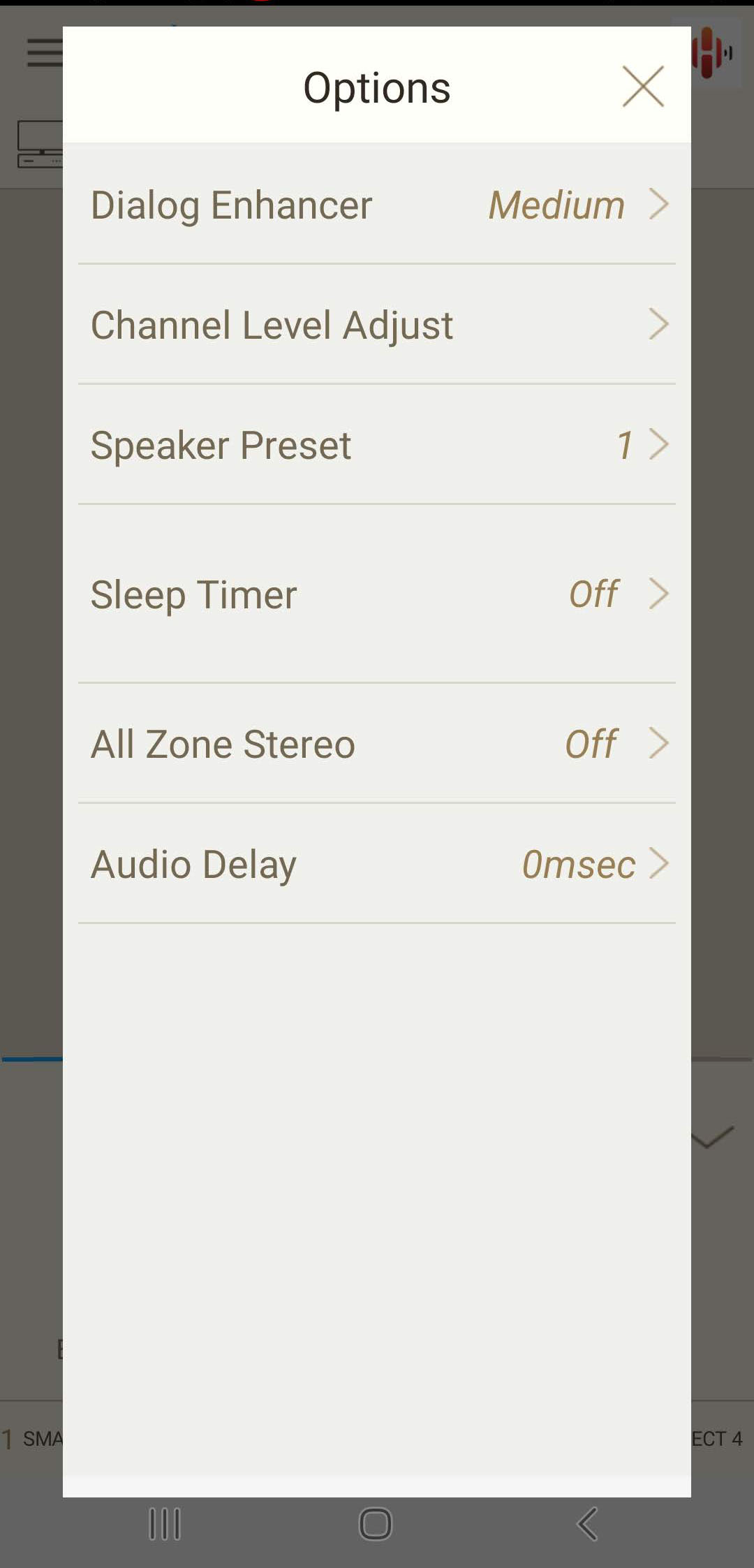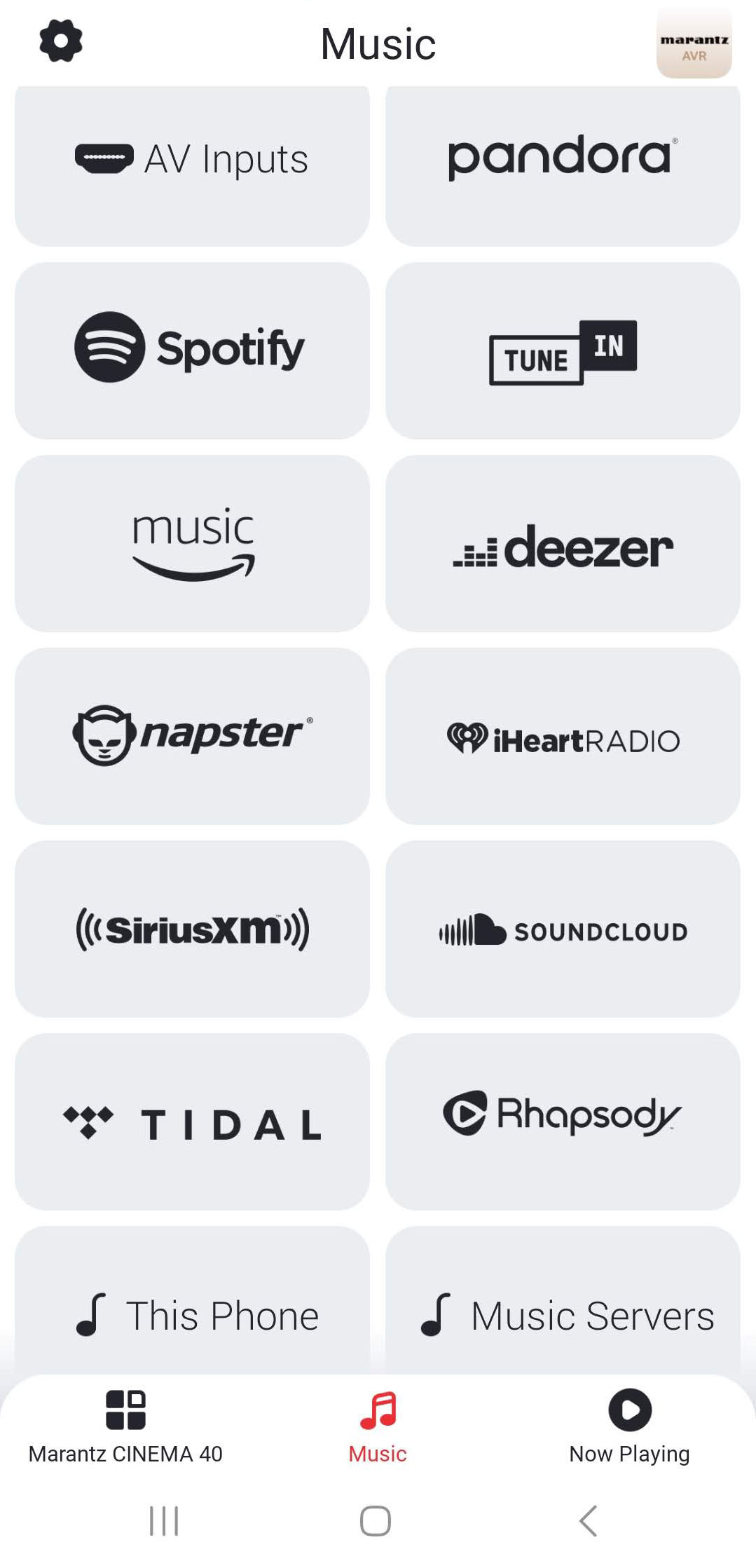If you look at the long list of features and specifications, it is not an overstatement to say that the Marantz CINEMA 40 is a beast of a receiver. From the state-of-the-art surround format processing to the latest 8K video support, the CINEMA 40 seems to have it all. But features alone do not make a great receiver, and Marantz as an experienced player in the field knows this well. The company spends considerable effort to design the inner engines of the CINEMA 40 to be able to deliver flagship-worthy performance. As this review suggests, this meticulous effort delivers excellence that can be heard and seen.
Marantz CINEMA 40 AV Receiver Highlights
- 9.4-channel AV receiver with 9 x 125 W onboard amplification.
- Four independently adjustable subwoofer outputs.
- Dolby Atmos, DTS:X, and Auro-3D surround processing formats.
- 8K Ultra video upscaling and HDMI pass-through with HCDP 2.3 support.
- Wireless app and HEOS (Home Entertainment Operating System) control features.
A few months back, I had a chance to review the Marantz CINEMA 60 AV receiver, which is the little brother of the CINEMA 40 reviewed here. Although I noted that the CINEMA 60 did not provide backward compatibility with older video devices that lack HDMI connectivity and had limited surround-processing capability, I came away impressed with its solid performance. With this positive experience, I jumped at the opportunity to review the CINEMA 40, which is the current top-of-the-line AV receiver in the series. The CINEMA 40 is offered at more than double the price of the CINEMA 60 ($3,500 vs $1,700) and in this competitive market segment, this fact alone should tell you that Marantz has the confidence that it has equipped the CINEMA 40 with significant features and performance enhancements worthy of its asking price. This review hopefully sheds some light on whether this is indeed the case.
The CINEMA 40 is advertised as a 9.4-channel receiver with 9 channels of onboard amplification and hence, it can accommodate a full-blown state-of-the-art Dolby Atmos or DTS:X setup. This alone already exceeds what the CINEMA 60 can offer. Moreover, the CINEMA 40 offers more extensive connectivity than its little brother. Let’s dig more into the features and performance of this beefy receiver.
Power Amplifier
Number of Powered Channels:
9
Power Output (8 ohms, 20 Hz – 20 kHz, 0.08% 2ch driven):
125 W
Power Output (6 ohms, 1 kHz, 0.7% 2ch driven):
165 W
Amplifier Topology:
Class A/B
Multichannel Surround Technologies
DTS:
DTS HD Master, DTS:X, DTS Neural:X, DTS Virtual:X
Dolby:
Dolby TrueHD, Dolby Atmos, Dolby Atmos Height Virtualization, Dolby Atmos Music, Dolby Surround
Number of Processing Channels:
11.4
Inputs/Outputs
HDMI In / Out:
7 / 3
Composite In / Out:
2 / 0
Component In / Out:
1 / 0
Analog In / Fixed Level Out:
5 in (including MM Phono) / 0 out
Digital In:
Optical / Coaxial 2 / 2
Multi-Room Out:
analog/digital 2 / 0
Multichannel Preamp Out:
11.4
Subwoofer Out:
4 (independent)
Number of Speaker Terminals:
11
Multi-Room Speaker Terminal:
assignable
Front Inputs:
USB-A
AM/FM Tuner:
Yes
HDMI
Total HDMI Inputs / No. Support 8K:
7 / 7
HDCP2.3 support:
Yes
HDMI Outputs: Main / Zone:
2 / 1
Max resolution @ framerate:
8K @ 60Hz, 4K @ 120Hz
HDMI Upscaling:
1080P/4K to 8K
Audio Return Channel:
ARC, eARC
Video Dynamic Range:
HDR, HLG, Dolby Vision, HDR10+, Dynamic HDR
Other HDMI features:
HDMI Pass-Through in Standby Mode, CEC, Auto Lipsync
Other Features
Acoustics Room Correction:
Audyssey MultEQ XT32
Music File Support Lossy formats:
MP3, WMA, AAC
Lossless formats:
FLAC HD 192/24, WAV 192/24, ALAC 192/24, DSD 2.8 MHz / 5.6MHz
Streaming Features:
HEOS, AirPlay 2
Network Connectivity:
Ethernet, Wi-Fi, Bluetooth (including retransmit for Bluetooth headphones
Smart Home Integration:
Alexa, Google Voice Assistant, Apple HomePod
Control Connectivity:
IP Control, RS232 Control, Web Control, App Control (Marantz AVR Remote App, HEOS)
Front Display:
2 line FLD + port hole OLED
General
Available Colors:
Black / Silver-Gold
Power Consumption:
710 W
Standby Consumption:
0.2 W
Network Standby Consumption:
Less than 2.0 W
Dimensions without antenna (W x D x H):
17.3ײ x 15.8ײ x 7.3ײ
Weight:
33.3 lbs
MSRP:
$3,500.00
Website:
Company:
SECRETS Tags:
Marantz, Marantz Cinema, Marantz Amplifier, Marantz Video, Marantz Reviews, Marantz Reviews 2023
The CINEMA 40 shares unmistakable DNA in the aesthetic department with the other receivers in the CINEMA series. It looks premium with excellent build quality. While retaining the classic Marantz’s porthole display and symmetrical knobs/buttons configuration, the handsome two-layer faceplate design style imparts an uncluttered and modern look. Most of its front-panel push-control buttons are cleverly hidden behind the bottom-hinged door, which covers almost the lower half of its slightly protruding center plate when closed. A good-size two-line FLD display is hidden behind this front-panel door, so if you want to get more information on the operational status of the receiver than what is shown in the porthole display, you can leave this door open. Both the porthole and FLD displays can be dimmed or turned off altogether. The setup microphone jack and the USB port for connecting an external hard disk or thumb drive are also located behind this door. When the front panel door is closed, only the power on/standby button, the headphone jack, the input-selector knob, and the volume knob are accessible with the porthole display as the sole operational status indicator of the unit. The finish of the review sample is black, which sports a two-tone dark gray and black two-layer appearance. For those who like a lighter finish, the silver-gold finish option is also available.
Secrets Sponsor
The CINEMA 40 is a 9.4-channel receiver equipped with a 9-channel Class A/B amplifier capable of delivering 125 W/channel (8-ohm load, 2-channels driven), which should be more than sufficient for most home applications. It has the capability to process the latest discrete multichannel audio formats, including Dolby Atmos with Height Virtualization, DTS:X with Virtual:X, IMAX Enhanced technology, and Auro-3D processing. Although the CINEMA 40 only has 9 amplified channels, it provides pre-outs for 11 channels, and hence it can handle 11-channel setups by using an additional 2-channel external amplifier or powered speakers. The CINEMA 40 also offers 4 discrete subwoofer low-level outputs, a feature that is rarely found on the surround processing home audio components in the market today. The bass management for the use of multiple subwoofers is sufficiently comprehensive, allowing the user to set the mode to Standard, where all the subwoofers will play the LFE signals plus the bass from any “small” speakers as a mono channel, or Directional, where each subwoofer will output bass below the crossover frequencies of the nearby “small” speakers in addition to the LFE signals, which are played by all the subwoofers. To get the optimum result from the Directional mode, the subwoofer layout needs to be properly configured (Front-left/front-right or front/rear for 2 subwoofers, front-left/front-right/rear for 3 subwoofers, and front-left/front-right/rear-left/rear-right for 4 subwoofers).
The CINEMA 40 comes with the Audyssey MultEQ XT32 automatic setup and room calibration system. It also offers optional Dirac Live room calibration, which can be purchased as an upgrade. Dirac Live provides a higher degree of adjustability and potentially can lead to better results, albeit with a steeper learning curve. For this review, only the included Audyssey calibration system was utilized.
I applaud the excellent video connectivity of the CINEMA 40, which is state of the art and provides backward compatibility with older video devices by the provision of the composite and component video inputs. On the HDMI front, there are 7 HDMI inputs, all with HDCP2.3 and up to 8K 60 Hz video support. The HDMI connection also has the upscaling HD video to Ultra HD (up to 8K) feature and accommodates high video dynamic range (including HDR10+, Dolby Vision), as well as a pass-through feature in standby mode.
Typical to modern AV receivers, the CINEMA 40 supports comprehensive network connectivity, both wired (ethernet LAN) and wireless (Bluetooth and Wi-Fi). Connecting the unit to the network during the initial setup process or through its menu system is relatively straightforward. Although you can operate the CINEMA 40 without a network connection, it is recommended to connect it to the network to make use of its network-exclusive features. For example, without the network connection, you will not be able to use the receiver for streaming music or controlling the operation of the unit using the Marantz AVR Remote app, which is available on Android or iOS. A network connection is also necessary if you want to use the voice control feature of the CINEMA 40 through Amazon Alexa, Google Assistant, or Apple HomePod.
Secrets Sponsor
Streaming music through the CINEMA 40 can be done using Bluetooth, AirPlay, or the built-in HEOS (Home Entertainment Operating System) feature, which can be accessed using the HEOS app. The HEOS app needs to be separately downloaded, but it can be linked to the Marantz AVR Remote app. The HEOS platform supports popular streaming services such as Pandora, Spotify, iHeart Radio, Deezer, and TIDAL. I found the HEOS platform to be sufficiently versatile as it can also stream music stored in your local NAS server. HEOS, however, does not support Qobuz. Hence, if you are like me, and use Qobuz as the main streaming service, you will need to resort to another way to stream the high-resolution content from Qobuz. Since the CINEMA 40 is a DLNA-certified product, a way around this is to play Qobuz through a DLNA-compatible app, such as BubbleUPnP app for an Android user. The streaming playback of the CINEMA 40 is capable of decoding PCM signals up to 24-bit/192-kHz and DSD signals up to 5.6 MHz (DSD128).
The remote control of the CINEMA 40 looks similar to the ones supplied with the other new Marantz audio products I reviewed recently (the Model 40n, the CD 60, and the CINEMA 60), which is a good thing. I like this latest Marantz remote design as they have nicely laid-out, clearly labeled buttons and they sit in hand nicely. This remote can be comfortably used in a dark room as it is backlit, which can be activated using the side key on the remote. During the review, I used this remote mostly for quick operations of the unit, such as turning the unit on/standby or changing inputs/volume levels. For more complex tasks, such as changing the sound mode or making adjustments to the sound settings on the fly, I preferred using the Marantz AVR Remote app, which also handily displayed the operation status of the unit (the volume level, the sound mode, the input selected, etc.).
Just like the other Marantz products I have tried, the CINEMA 40 provides an easy-to-follow on-screen step-by-step setup guide. You just need to connect the HDMI output of the receiver to the TV, turn it on, and then follow the on-screen setup guide, which covers the connections of the input devices, the network setup, the speaker setup, and the calibration process. For this review, I used the Xfinity X1 4K TV box and Oppo UDP-203 universal player as the HDMI sources. Seven speaker setup were used, which includes the Revel Ultima Studio pair as the two front mains, the Revel C50 as the center channel, and the Revel Concerta M8 speakers as the surrounds. Two SVS SB-3000 subwoofers in the front-left and front-right were utilized. The included Audyssey MultEQ XT32 system (the built-in feature and the calibration microphone) was used for the sound calibration process and the result was spot on. Only minor adjustments were made after the calibration to tailor it better to my preference.
Modern AV receivers these days are expected not just to have good surround-sound processing but also video switching/processing capabilities. On the video side, the CINEMA 40 has state-of-the-art video switching capabilities and is capable of handling up to 8K resolution video signals. While the 8K video functionality was not tested, the receiver showed poise and competence in performing upsampling and video switching in all its other features up to 4K signal resolutions. I certainly did not observe any differences between the quality of the video signals switched through the receiver versus the output of the one directly to the TV. Its upsampling feature worked as advertised, producing good results with no noticeable artifacts.
On the surround-sound side, the CINEMA 40 excels in its feature set but also in its sonic performance. In comparison to the CINEMA 60, which in my opinion was already a great surround performer, the CINEMA 40 came across as more even keel in many aspects of its sonic performance. Overall, the CINEMA 40 indulged me with its steady and accurate surround steering, great immersion of sonic envelopment, and excellent sonic balance across the frequency spectrum. Its onboard amplifier is sufficiently powerful to effortlessly fill my relatively large living room with a theater-like volume level and deliver the necessary sonic impacts when called for. And the Directional subwoofer mode delivered the best bass effects that I had ever experienced in my setup. It gave me the most even bass distribution and an enhanced sense of low-frequency directional effects, which might otherwise be hidden in a mono subwoofer signal mode.
The NBA playoffs were ongoing during the time when I reviewed the CINEMA 40. I used some of these live playoff games to test the surround envelopment experience and came away satisfied. The receiver did an excellent job in decoding the live Dolby Digital soundtrack and recreating the front-court experience of watching the games in a crowded sports arena atmosphere with fans’ cheers/jeers from all around. The commentators’ voices were conveyed clearly in the middle of the noisy environment of the arena. It was truly an enjoyable TV sports-watching experience.
The Pale Blue Eye movie, which stars Christian Bale, has rich sound content that helps in creating the grim ambiance of the story. The CINEMA 40 skillfully delivered this Dolby Atmos content and recreated all the sonic nuances without missing a beat. The sometimes-subdued dialogue in the movie was legibly produced along with excellent sound field envelopment, including the sense of bass envelopment, which helped in creating a believable ambiance depicted in the scenes of the movie. The CINEMA 40 potently captured and delivered all textures and impacts in the whole soundtrack of this movie. The surround effects in the climax scene involving a blazing fire in the old building were convincingly delivered, immersing me in the heart of the action of the scene. It was a captivating watching experience.

The CINEMA 40 also fleshed out awesomely the lively Dolby Atmos soundtrack mix of the fun Apple TV+ romantic action movie Ghosted, starring Ana de Armas and Chris Evans. The directional surround effects accompanying the action sequences in the movie sounded accurate and were delivered with sufficient impact. The receiver’s ability to decipher dialogue intelligibly in the middle of the busy action sequences was nothing short of excellent. Even though I did not use height-effect speakers, the scene with a helicopter flying above really sounded convincing above my head, indicating the effectiveness of its height virtualization feature. The sense of space that the receiver managed to deliver from the soundtrack was impressive.

Although surround performance was its stated forte, the CINEMA 40 also excelled in stereo music applications. It generally produced a clear, full-sounding, and well-balanced sound character with a hint of warmth. It’s MM phono and headphone sonic performance were respectable. Its versatility as a streamer was especially commendable. I streamed various music file formats (DSD, FLAC, WAV, and MP3) through the built-in HEOS feature without any glitches. Streaming ‘S Wonderful from Diana Krall’s The Look of Love album (2001) through Tidal, I was indulged with its smooth yet detailed presentation. I was impressed by the natural vocals, the balance across the frequency spectrum, as well as the sound staging of the overall presentation. It might not beat a high-end two-channel system in its stereo performance, but undeniably it was no slouch in this department.

Diana Krall “The Look of Love “
Even though I do not usually listen to my music in surround, I tried the surround music features that the CINEMA 40 has anyway, namely Dolby Surround, DTS Neo:X, and Auro-2D surround. To me, the Auro-2D surround, which processed the surround using the Auro-3D decoder, stood head-and-shoulders above the others in this application. The Auro-2D surround processing seemed to be able to preserve the imaging and sound staging of the recording while adding a sense of space to the music. Your mileage may vary, but if you like listening to surround music, I think Auro-2D surround is definitely worth trying.
The Marantz CINEMA 40 is truly a great receiver. Not only is it equipped with versatile features but it is also capable of delivering first-rate sonic performance worthy of its flagship status.
- Well-built and aesthetically appealing appearance
- Inclusion of Auro-3D on top of the usual Dolby Atmos and DTS:X surround processing
- Four discrete subwoofer outputs
- Streaming function with HEOS built-in
- Sufficiently powerful onboard amplifier
- Solid audio performance in stereo and surround applications
- Backlit remote control
- App control feature
The Marantz CINEMA 40 is an awesome receiver, period. It embraces its top-of-the-line status with its comprehensive feature set, great looks as well as build quality, and, more importantly, with its unwavering performance. All aspects of the receiver, be it the state-of-the-art video processing or its surround performance, or even it’s stereo music performance, are first-rate. The CINEMA 40 is truly a jack-of-all-trades entertainment control device that leaves very little room for its competitors. It is not cheap but, in my opinion, it brings with it noteworthy features and excellent performance beyond its asking price.









